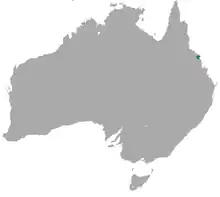Proserpine rock-wallaby
The Proserpine rock-wallaby (Petrogale persephone) is a species of rock-wallaby restricted to a small area in Conway National Park, Dryander National Park, Gloucester Island National Park, and around the town of Airlie Beach, all in Whitsunday Shire in Queensland, Australia. It is a threatened species, being classified by the IUCN as endangered.[2]
| Proserpine rock-wallaby[1] | |
|---|---|
| Scientific classification | |
| Domain: | Eukaryota |
| Kingdom: | Animalia |
| Phylum: | Chordata |
| Class: | Mammalia |
| Infraclass: | Marsupialia |
| Order: | Diprotodontia |
| Family: | Macropodidae |
| Genus: | Petrogale |
| Species: | P. persephone |
| Binomial name | |
| Petrogale persephone Maynes, 1982 | |
 | |
| Proserpine rock-wallaby range | |
The Proserpine rock-wallaby is mostly grey in colour and is a timid grass-eater that rarely ventures far from rock shelter.[3] It is distinguished from the many other rock wallabies found in northeastern Queensland by its larger size and longer tail, tipped with white. It was unknown to science until 1977, when a single individual was captured after farmers at Proserpine had spoken of a strange form of rock wallaby in the area.[4]
The Proserpine rock-wallaby is found only in a relatively intensively-settled area, but it is in competition with other more successful rock-wallaby species, which competition is probably responsible for its threatened status.[5]
Threats and Conservation
The Proserpine rock-wallaby is threatened by multiple factors. It's habitat has declined from increased urbanization and tourism, leading it vulnerable to road kill and predation from domestic dogs and cats.[6][7] Inbreeding and hybridization between the Prosperine and Unadorned rock-wallaby species also threatens the population. It's feeding habits make it vulnerable to consuming introduced toxic plants like the pink periwinkle.[6]
Current conservation strategies for this species involve the acquisition of protected habitat, adding wildlife reflectors to roadkill zones to prevent further fatalities, and controlling toxic plants near their habitat.[8]
References
- Groves, C. P. (2005). Wilson, D. E.; Reeder, D. M. (eds.). Mammal Species of the World: A Taxonomic and Geographic Reference (3rd ed.). Baltimore: Johns Hopkins University Press. p. 68. ISBN 0-801-88221-4. OCLC 62265494.
- Burnett, S.; Winter, J. (2019). "Petrogale persephone". IUCN Red List of Threatened Species. 2019: e.T16747A21955635. doi:10.2305/IUCN.UK.2019-1.RLTS.T16747A21955635.en. Retrieved 19 November 2021.
- Menkhorst, Peter (2001). A Field Guide to the Mammals of Australia. Oxford University Press. p. 132.
- Karl Shuker; Gerald Durrell (1993). Lost Ark: New and Rediscovered Animals of the Twentieth Century. HarperCollins Publishers. p. 81. ISBN 0-00-219943-2.
- Maynes & Sharman, G.M. & G.B. (1981). Proserpine Rock-wallaby in The Complete Book of Australian Mammals Ronald Strahan) (ed.). Oxford University Press. p. 220.
{{cite book}}: Missing or empty|title=(help) - Nolan, Barry; Johnson, Peter (9 March 2001). "Proserpine Rock-wallaby (Petrogale persephone) Recovery Plan 2000-2004". Australian Government.
- Eldridge, M. D. B.; Johnson, P. M.; Hensler, P.; Holden, J.; Close, R. L. K. (2008). "The distribution of three parapatric, cryptic species of rock-wallaby (Petrogale) in north-east Queensland: P. assimilis, P. mareeba and P. sharmani". Australian Mammalogy. 30 (1): 37–42. doi:10.1071/am08004. ISSN 1836-7402.
- "Species Profile and Threats Database Petrogale persephone — Proserpine Rock-wallaby". Australian Government.
External links
- Australian Department of Environment and Heritage Species Profiles
- Animal Info on the Proserpine rock-wallaby
- https://web.archive.org/web/20070219182919/http://www.jcu.edu.au/school/tbiol/zoology/auxillry/mammals/prossy.htm (includes photos)
